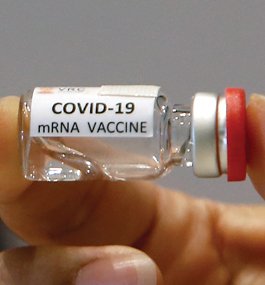On the Cusp of a COVID-19 Vaccine
Decades of painstaking research may hold the key to the end of a global pandemic.

Chaiwat Subprasom/SOPA Images/LightRocket via Getty Images
by Lawrence Goodman
It is no exaggeration to say that Drew Weissman ’81, MA’81, P’15, is among a handful of scientists whose research may save the world from COVID-19.
Almost 23 years ago, Weissman began studying how messenger RNA (mRNA), which is involved in protein synthesis, could be used to create vaccines. Now his findings and the system he developed to deliver mRNA into cells underpin two of the reportedly most-promising coronavirus vaccine candidates, one being developed by Pfizer and BioNTech, and the other by Moderna.
Both companies have reported substantial progress in recent months. Weissman believes either will have a vaccine on the market by early next year, though making it widely available to the public will take longer.
Weissman, a professor of medicine at the University of Pennsylvania’s Perelman School of Medicine, is low-key about the highly anticipated implications of his research. “I’ve been working on RNA my entire career,” he says. “It’s what I’m good at, what I find enjoyment in.”
At Brandeis, Weissman studied biochemistry, working in Professor Gerald Fasman’s lab. “Professor Fasman definitely gave me insights on how to develop hypotheses — how to think about them, how to develop new lines of research,” he says. Weissman wrote his master’s thesis on acetylation of DNA, part of the process of gene regulation, before going on to earn an MD/PhD in immunology/microbiology at Boston University. Arriving at Penn in 1997, he began collaborating with biochemist Katalin Karikó on using mRNA as the basis for a vaccine.
Messenger RNA molecules transport instructions from DNA to the ribosomes in cells for the production of proteins. In a vaccine, these molecules are synthesized and custom-designed to get cells to produce proteins associated with a selected virus. The proteins trick the immune system into thinking the body is infected with the virus; in response, cells produce antibodies to create at least partial immunity.
In a conventional chickenpox, polio, flu or rabies vaccine, a weakened or killed version of the virus is injected, and the immune system is fooled into fighting the disease. But manufacturing a virus is a lot more expensive than synthesizing mRNA. It isn’t necessary to create an entirely new vaccine for each disease using mRNA, since the mRNA can be reprogrammed to fight the target illness.
The early days of Weissman and Karikó’s research were tough going. They and other scientists injected mRNA into mice, causing deadly inflammation. While many researchers abandoned mRNA research, Weissman and Karikó persisted. “We were getting interesting results, which just kept leading us on,” Weissman says.
In the mid-2000s, Weissman and Karikó announced they’d discovered a way to modify mRNA to avoid inflammation, a seemingly simple fix, though it took years of careful research. They replaced one of mRNA’s four chemical building blocks, a nucleoside called uridine, with a slightly modified nucleoside called pseudouridine. This enabled the mRNA to skirt the body’s immune system.
Several years later, Weissman devised a method of packaging mRNA inside a lipid nanoparticle — a small bubble of oil — to prevent the molecule from falling apart as it traveled through the body. “We basically tested every possible delivery system and found this was the best,” Weissman says.
More major breakthroughs followed in the late 2010s. The researchers used mRNA to immunize mice against genital herpes (caused by the herpes simplex virus), influenza, Zika and HIV.
Even though an mRNA-based vaccine has never been developed for humans, Weissman believes the ones in development for COVID-19 will work because it’s a much simpler virus than many others. “Coronavirus is a lot easier to make a vaccine against than HIV,” he says.
If it works, a COVID-19 mRNA vaccine will spur human cells to produce the spike-shaped protein found on SARS-CoV-2, the virus that causes the illness, and will trigger the immune system to produce protective antibodies.
Weissman laments the way politics has interfered with the U.S. response to COVID-19 and the development of a vaccine. “That’s just not how science is supposed to work,” he says.
Nevertheless, he is focusing on an even more ambitious project: developing a vaccine for all coronaviruses. Besides SARS-CoV-2, two other lethal varieties of coronavirus — SARS and MERS — have spread among humans in recent years.
“Instead of shutting down the world for a year while you make a new vaccine, we’ll have a vaccine ready to go,” Weissman says.
